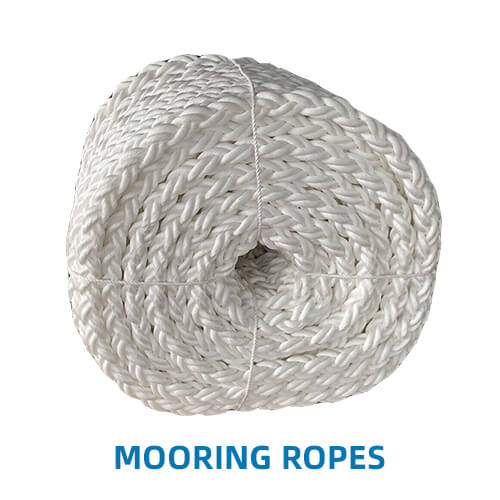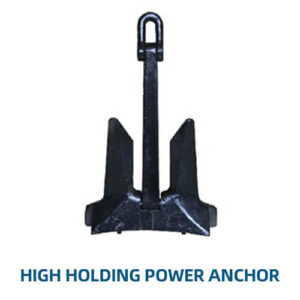Key Features of Mooring Ropes:
- Material:
- Synthetic Fibers: Commonly made from high-strength synthetic fibers such as nylon, polypropylene, polyester, or a blend of these materials. Synthetic fibers offer durability, flexibility, and resistance to marine conditions.
- Natural Fibers: Less common, but traditional options like Manila or sisal may still be used in some applications.
- Construction:
- Braided: Mooring ropes are often braided for enhanced strength and flexibility. Braided ropes can be either three-strand or multi-strand, with multi-strand braids offering greater strength and flexibility.
- Twisted: Some mooring ropes are twisted, which can provide good tensile strength but may be less flexible than braided ropes.
- Specifications:
- Diameter: Available in various diameters, ranging from small ropes for lighter vessels to large ropes for heavy-duty applications. The diameter impacts the strength and handling characteristics of the rope.
- Length: Customizable to meet specific mooring requirements, with lengths ranging from short ropes for small boats to long ropes for large ships and marine installations.
- Breaking Strength: Rated by the maximum load the rope can handle before breaking. This is a crucial factor in selecting the appropriate rope for a given application.
- Types:
- Single Braid Ropes: Made from a single layer of braided fibers, providing good strength and flexibility for general mooring applications.
- Double Braid Ropes: Consist of an inner core and an outer braid, offering high strength, abrasion resistance, and reduced stretch. Ideal for applications requiring durability and load-bearing capability.
- Three-Strand Ropes: Made from three twisted strands, offering simplicity and strength. Suitable for various mooring applications, especially where flexibility and ease of handling are important.
- Applications:
- Dock and Pier Mooring: Used to secure vessels to docks and piers during berthing and mooring. Provides stability and helps manage the movement of the vessel.
- Ship-to-Ship Mooring: Employed in ship-to-ship transfer operations to secure lines between two vessels. Ensures stability and safe handling during the transfer of cargo or personnel.
- Marine and Offshore Platforms: Used to moor floating platforms, oil rigs, and other offshore structures. Provides secure anchoring and stability in challenging marine environments.
- Performance and Benefits:
- Strength: Designed to handle significant loads and stresses associated with mooring operations, ensuring vessel stability and safety.
- Flexibility: High flexibility allows for easy handling and adjustment of mooring lines, making them suitable for a variety of applications.
- Durability: Made to withstand harsh marine conditions, including saltwater exposure, UV rays, and physical abrasion.
- Maintenance and Care:
- Inspection: Regularly inspect mooring ropes for signs of wear, fraying, or damage. Check for any signs of reduced strength or integrity.
- Cleaning: Clean ropes to remove salt, debris, and other contaminants that could affect their performance. Rinse with fresh water and allow to dry thoroughly.
- Storage: Store ropes in a dry, shaded area when not in use to prevent damage from UV rays and moisture. Avoid storing them in areas where they could become tangled or damaged.
- Safety Considerations:
- Load Rating: Ensure the mooring rope is rated for the specific load requirements of the vessel and mooring operation. Using ropes with insufficient strength can lead to failure and accidents.
- Proper Handling: Handle ropes carefully to avoid damage during use and storage. Ensure proper knotting and securing techniques to prevent accidental release or slipping.
- Replacement: Replace any ropes that show significant signs of wear or damage to maintain safety and performance.
Advantages of Mooring Ropes:
- High Strength: Capable of handling heavy loads and stresses, providing reliable mooring and stability for vessels.
- Flexibility: Allows for easy handling, adjustment, and manipulation during mooring operations.
- Durability: Designed to resist marine conditions, including corrosion, UV exposure, and physical wear.
Considerations for Mooring Ropes:
- Selection: Choose the appropriate type, diameter, and length of mooring rope based on the specific needs of the vessel and mooring environment.
- Maintenance: Regularly inspect and maintain mooring ropes to ensure their continued performance and safety.
- Compliance: Follow industry standards and regulations for mooring rope specifications and maintenance to ensure safety and effectiveness.
Mooring ropes are crucial for safe and effective mooring operations in various marine settings. Their strength, flexibility, and durability make them essential for securing vessels and marine structures, ensuring stability and preventing damage.






